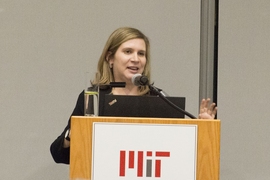Every several years, a series of climatic changes called an El Niño affects the Pacific Ocean regions, causing significant drought and fires. During the 2015 El Niño, Indonesia experienced an intense fire season which lasted from September through October, emitting an abundance of carbon dioxide and methane into the atmosphere and causing massive smoke plumes to form over neighboring countries, including Singapore.
Department of Civil and Environmental Engineering Professor Charles Harvey and Fuu Ming Kai, a former postdoc from the Singapore-MIT Alliance for Research and Technology, worked in collaboration with researchers from the University of California at Irvine to publish a paper in the Proceedings of the National Academy of Sciences, where they discuss radiocarbon measurements on the Indonesian fires and confirm that the smoke is originating from burning peatlands, rather than the popular belief of deforestation and waste burning.
Harvey and Kai, who have been conducting research in the region since 2014, sampled and carbon dated the carbonaceous aerosol from September of 2014 to October of 2015. The results of their study found that the carbon level of the smoke plume had an intermediate age ranging from 1,000 to 3,000 years old. This confirmed that approximately 85 percent of the smoke was come from burning peatlands.
Tropical peatlands may contain as much carbon as the amount consumed in nearly a decade of global fossil fuel use, and raging peat fires in Indonesia alone have been estimated in some years to contribute 10 to 40 percent as much greenhouse gas to the atmosphere as all the world’s fossil fuel burning.
According to Harvey and Kai, there has been a rapid change in land use over the past few decades, creating extreme vulnerability to anthropogenic fire.
“Throughout the past 20 years, the majority of tropical forests have been cleared in order to create palm oil plantations,” Harvey says.
A number of factors, such as intense deforestation and soil draining for agricultural production — in conjunction with severe droughts — have created persistent peat fires which are able to thrive underneath agricultural land and sustain themselves even in low temperature and oxygen levels. During the El Niño and dry periods, the landscape itself burns and creates a substantial haze over major cities such as Singapore.
The smoke haze in Singapore significantly reduces air quality of cities across the maritime continent, contributing to health problems — including deaths — for over 40 million people. It also damages plant and animal habitats. The effects are significant, and prior to this research, have often been overlooked due to uncertainties about the cause and origin of the smoke plumes.
The new findings provide a sense of urgency to take action and influence a change in policy regarding land use. Harvey and researchers are currently experimenting with the replanting of native trees on a new field area that was deforested and burned, an innovative process that has never been successfully implemented before.
“We are trying to see if we can bring it back to life,” says Harvey. “Ideally, the trees could be sustainably harvested for their lumber, and it would help stop the peat burning.”
Harvey and the researchers are optimistic about the future, saying that their findings could initiate a fundamental change, which would ultimately alleviate a majority of the peat burning, reduce respiratory problems due to smoke plumes, and improve plant and animal habitats.
“The study directly measures the contribution of fires on peatland to smoke in Singapore and confirms that peat fires are major sources compared with deforestation and agricultural burning on mineral soils,” says Ruth DeFries, professor of ecology and sustainable development at Columbia University, who was not involved with this research. “Smoke from peat fires leads to reduced air quality far downwind of the fires, indicating the importance of controlling fires for the health of people living in the region.”












